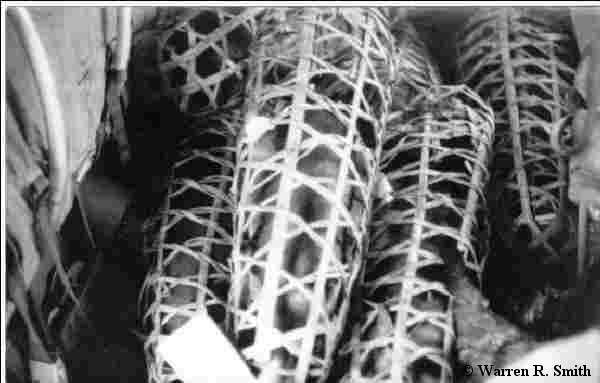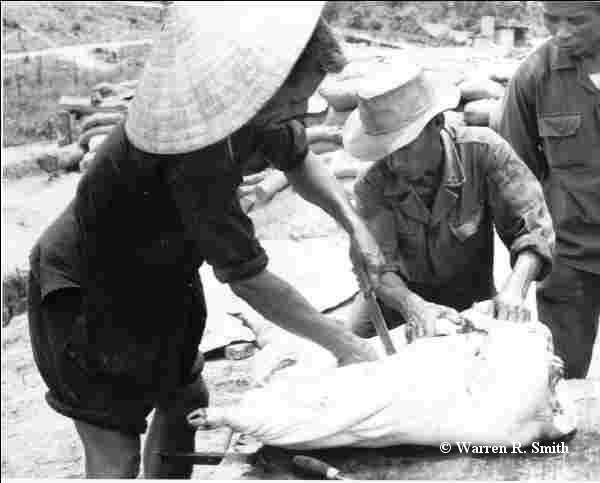Chops in Choppers, Vietnamese Style Meals on Wheels
As we approach the year 2000 and beyond, the term resupply
to Marine helicopter crews generally means arriving at a predetermined
point to pick up palletized loads of meals ready to eat (MREs), ammunition,
water and other heavy and bulky items which will probably be carried externally
to the recipient. Other times the mail, hot chow and other items
will be loaded internally. When the receiver is a U.S. Marine organization
the types of supplies are fairly well standardized for efficiency.
The Marines of the 1964 - 1965 time frame in Vietnam were not operated
with the techniques, aircraft nor the modern supply system of the 21st
Century. Additionally, they did not fly resupply missions to
U.S. forces but rather to the Army of the Republic of Vietnam (ARVN) and
their small cadre of U.S. Army Special Force advisors.
The outposts manned by the ARVNs, and their advisors,
relied on HMM-364 for their supplies since few, if any, roads lead to them.
Most of the time they were carved out of the jungle or located on the tops
of hills or mountains. Now, some will say, "That's no different than
the mission might be today." Well, in 1964 -1965 the Vietnamese supply
system was far from that of the Marine Corps' and it was barely able to
keep those at these outposts alive. Without generators to supply
electricity to power refrigeration units, meat had to be brought in alive
and the animals were slaughtered and eaten as needed. This need for
live meat sometimes converted the UH-34 into a flying cattle car.
Fresh vegetables, rice, fruits and varied types of ammunition were also
delivered and the majority of it was hauled within the cabin area of the
helicopter.
(click for larger
image)
 Because
nothing in the supply system was standardized as expected today, preparation
for the resupply commenced when the Vietnamese resupply truck pulled up
to where the aircraft of HMM-364 were staged. It was then that the
crew saw a hodgepodge of items thrown together and they had their first
clue as to what the supplies consisted of. SSgt. John C. Thompson
can be seen directing the distribution of items to various helicopters.
Because
nothing in the supply system was standardized as expected today, preparation
for the resupply commenced when the Vietnamese resupply truck pulled up
to where the aircraft of HMM-364 were staged. It was then that the
crew saw a hodgepodge of items thrown together and they had their first
clue as to what the supplies consisted of. SSgt. John C. Thompson
can be seen directing the distribution of items to various helicopters.
Warren R. Smith, former Cpl. USMC recalls, "On one
resupply mission I think the logistics people got their wires crossed.
We received truck load after truck load of large melons to take to an outpost
that had a small airstrip with the base located up the hill from the strip.
When we arrived there wasn't a sole there to assist in unloading and moving
the melons up to the outpost. We unloaded them in piles next to the
helicopter. It got quite comical as succeeding aircraft arrived at
the zone and tried to find a place to land among the piles of melons left
by previous flights."
(click for larger image)
 HMM-364
transported large pigs (80 lbs) and small pigs (60 lbs.) that were packaged
in triangular shaped reed baskets. Occasionally, they would escape
from their reed baskets and would be asked to leave the aircraft.
These pot bellied animals were later sought as pets by citizens of the
United States and other countries.
HMM-364
transported large pigs (80 lbs) and small pigs (60 lbs.) that were packaged
in triangular shaped reed baskets. Occasionally, they would escape
from their reed baskets and would be asked to leave the aircraft.
These pot bellied animals were later sought as pets by citizens of the
United States and other countries.
(click for larger image)
 This
pig was being slaughtered for dinner. The outpost was very close
to the border of Laos.
This
pig was being slaughtered for dinner. The outpost was very close
to the border of Laos.
(click for larger image)
 Chickens
and ducks were tied together by their feet with about six to each bundle.
The crew found it quite annoying when reaching into the piles of foul to
find the leg bundles for offloading. That unwelcome hand which was going
to give them a lift to some hungry troops in the field was generally pecked
at with vigor.
Chickens
and ducks were tied together by their feet with about six to each bundle.
The crew found it quite annoying when reaching into the piles of foul to
find the leg bundles for offloading. That unwelcome hand which was going
to give them a lift to some hungry troops in the field was generally pecked
at with vigor.
(click for larger image)
 As
mentioned earlier, lack of standardization made resupply a cumbersome task.
One of the reasons depicted here was the use of so many different type
and caliber weapons carried by the ARVNs. Note in the picture, from
left to right, the first soldier is fiddling with a hand grenade, the next
has a 12 gauge shotgun, the next a Thompson .45 cal., the next an M-1 carbine
and the next an M-1 Garand. There were also a number of 9mm weapons
used. There were certainly additional types of personal weapons
not mentioned here.
As
mentioned earlier, lack of standardization made resupply a cumbersome task.
One of the reasons depicted here was the use of so many different type
and caliber weapons carried by the ARVNs. Note in the picture, from
left to right, the first soldier is fiddling with a hand grenade, the next
has a 12 gauge shotgun, the next a Thompson .45 cal., the next an M-1 carbine
and the next an M-1 Garand. There were also a number of 9mm weapons
used. There were certainly additional types of personal weapons
not mentioned here.
(click for larger image)
 The
ARVNs also had herds of cows that pastured in the fields around their barracks.
These cattle appeared to be a cross between the Brahma and the Guernsey
types found in the United States. The major difference was their
size. They were much smaller than either breed found in the States.
The problem with cows is, the bigger the animal the larger the mess they
leave behind in the aircraft.
The
ARVNs also had herds of cows that pastured in the fields around their barracks.
These cattle appeared to be a cross between the Brahma and the Guernsey
types found in the United States. The major difference was their
size. They were much smaller than either breed found in the States.
The problem with cows is, the bigger the animal the larger the mess they
leave behind in the aircraft.
(click for larger image)
 Cpl.
Smith recalls an incident, "I seem to remember an Air Force C-123 taking
20 cows out of Da Nang when it jammed a landing gear on retraction.
The crew was, of course, not going on to their destination but rather were
going to make an emergency landing back at Da Nang. They had a big
problem however, they didn't want to become pressed meat on their landing
with cows being thrown toward the front of the cargo bay. Their solution
was to fly over Da Nang harbor, open the rear door and herd the cattle
out without parachutes. I chuckle every time I hear someone say,
"Thank God cows can't fly."
Cpl.
Smith recalls an incident, "I seem to remember an Air Force C-123 taking
20 cows out of Da Nang when it jammed a landing gear on retraction.
The crew was, of course, not going on to their destination but rather were
going to make an emergency landing back at Da Nang. They had a big
problem however, they didn't want to become pressed meat on their landing
with cows being thrown toward the front of the cargo bay. Their solution
was to fly over Da Nang harbor, open the rear door and herd the cattle
out without parachutes. I chuckle every time I hear someone say,
"Thank God cows can't fly."
Cpl. Smith recounts another memory, "Rice was always
a standard item to be delivered, and if I recall correctly, the rice came
220 lb. sacks. We would pile them by the door so in case we started
to lose rotor RPMs, we could kick a lot of weight out quickly. It
always amazed me how the small ARVN troops could put one of those sacks
on their back and run off with them at a brisk pace. On the other
hand, they didn't seem to have the strength to assist in unloading ammunition
boxes when we were making deliveries. If you were hauling rice, you
almost always had a case or two of the fish oil sauce. Break one
of those bottles and you would have to fly with your head out the door
or window until it could be cleaned up. Every time I had to change
a fuel tank I tried not to think of all the things that had drained down
and through the floor of the aircraft."
Information provided by:
Warren R. Smith, former Cpl. USMC
(pictures included)
HOME
 Because
nothing in the supply system was standardized as expected today, preparation
for the resupply commenced when the Vietnamese resupply truck pulled up
to where the aircraft of HMM-364 were staged. It was then that the
crew saw a hodgepodge of items thrown together and they had their first
clue as to what the supplies consisted of. SSgt. John C. Thompson
can be seen directing the distribution of items to various helicopters.
Because
nothing in the supply system was standardized as expected today, preparation
for the resupply commenced when the Vietnamese resupply truck pulled up
to where the aircraft of HMM-364 were staged. It was then that the
crew saw a hodgepodge of items thrown together and they had their first
clue as to what the supplies consisted of. SSgt. John C. Thompson
can be seen directing the distribution of items to various helicopters.





